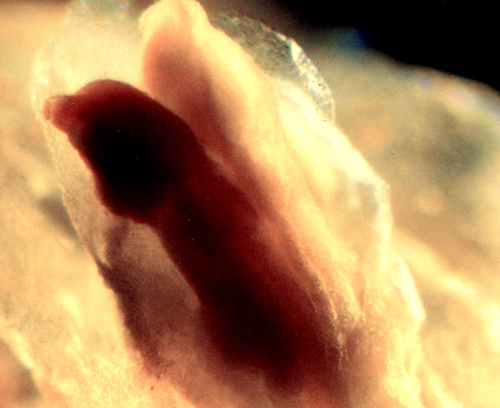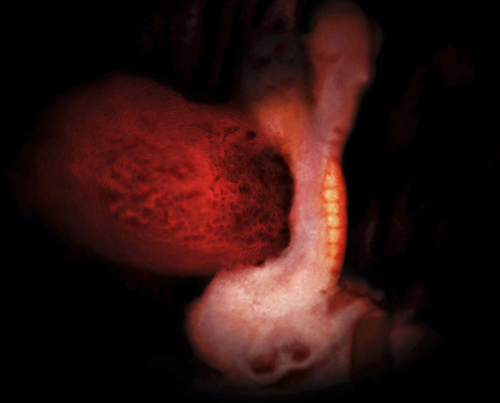You are 4 Weeks and 6 Days 246 days to go…
The placenta—the structure that will become your unborn baby’s lifeline—is forming.
Your baby today
The upper part of the embryo is shown. There is still a wide
opening along the back of the embryo that will gradually close over the
next few days. The head and lower spine portions are the last to close.

Your pregnancy test result may be the only sign
that you’re pregnant, but there are many fascinating changes taking
place inside you. The basic structures that will form the placenta (see You are 10 Weeks Exactly)
are now in place. The outer layer of cells that originally entered the
lining of the uterus are now coated with projections of placental
tissue. It is the outer cells that are in direct contact with small
lakes of your blood. The inner placental projections or fronds are
termed “villi.” Some villi anchor the pregnancy to your tissues and,
from these, smaller free-floating villi arise. Later, more branches will
appear and ultimately resemble the branching pattern of a fern leaf.
The villi are still immature and have not established a blood supply of
their own. It will be several weeks before the placenta is mature enough
to supply all the oxygen and nutrients that your developing baby needs.
… Mom
| Q: |
I really wanted a baby, but now that I have a positive
pregnancy test result, I’m suddenly not so sure. Is this normal?
|
| A: |
I felt exactly the same at first and after talking to friends
discovered that lots of them had mixed feelings, especially at the
beginning. I found a good way to overcome this was to focus on the
reasons why I wanted the baby. I wrote these down. Then I tried to
figure out what I was really worrying about. Was it the thought of
giving up some freedom? Financial worries? Concerns that I wouldn’t be a
good parent? This helped me get things in perspective and realize I
really did want the baby.
|
If you have any doubts while you’re pregnant,
try talking to a close female relative—perhaps your mom—or a friend.
You’re likely to find they, at times, had similar doubts, but went on to
enjoy their pregnancy and being a mother.

Seeing your Doctor
If you’ve had a
positive pregnancy test, call your doctor’s office to schedule your
first prenatal visit, which will be between 8 and 12 weeks. The
receptionist will likely ask the date of your last menstrual period to
properly time the appointment.
At the appointment,
your doctor will confirm your home pregnancy test results with urine
and blood tests and possibly an ultrasound, as well. She will also
determine your estimated due date based on the date of your last
menstrual period.
This first visit
will typically be your longest appointment, since the doctor will give
you a thorough physical examination, take your family and personal
health history, and answer any of your pregnancy-related questions or
concerns.
You will be weighed and have your blood pressure checked.
You’ll also have blood drawn for several tests, including your blood type, Rh status, and a variety of sexually transmitted diseases.
You are 5 Weeks Exactly 245 days to go…
At this important stage of development, the building blocks of your baby’s spine are being laid down.
Your baby today
The bulge at the lower part of this image will eventually become
the baby’s head. Segments called somites (seen as bright, round areas
running down one side of the embryo), which will form the baby’s spine,
have started to develop.

By the end of this 5th week, individual elements that will form the embryo have begun to develop.
Starting at what will
become the head end, individual segments, called “somites,” form.
Roughly three new pairs of somites appear every day and each forms part
of your baby’s spine as well as the muscles associated with each segment
of the body. Eventually there will be four somites at the head, eight
in the region of the neck, 12 at chest level, five in the lumbar region,
and five in the pelvic area.
More somites develop in the baby below the pelvis but most disappear. In other mammals, these develop to form the tail.
… Your body
Your metabolism
Regular exercise will increase
your base metabolic rate, which is the rate at which your body burns
calories. During pregnancy your metabolism will already be slightly
elevated. When exercising your body will be encouraged to use up excess
energy and fat reserves, but will always keep enough reserve energy to
facilitate the growth of your baby.
Exercise will also help your body regulate blood sugar and energy levels.
Doing moderate aerobic exercise during pregnancy—such as walking or running—regularly will burn excess fat, but won’t affect your baby’s development.

… Nutritionist
| Q: |
I’m underweight. Could this affect my pregnancy?
|
| A: |
You may be more likely to suffer from nutritional
deficiencies, which could affect the baby’s health; you are also more
likely to give birth prematurely, and have a smaller-than-usual baby,
who is more vulnerable to health problems.
To gain
weight, eat bigger portions and choose healthy foods that have plenty of
protein, good-quality fats, and unrefined carbohydrates (see Get carb loading).
Opt for nutrient- and calorie-dense foods, such as avocados and
whole-milk dairy products; eat lots of leafy greens to ensure you are
getting key vitamins and minerals .
Eat healthy snacks, such as nuts, fruit, and seeds, and don’t skip
breakfast. Your doctor will refer you to a dietician, if necessary.
|
Actual size of your baby
At 5 weeks of pregnancy, the embryo is 0.09 in (2.5 mm) long.